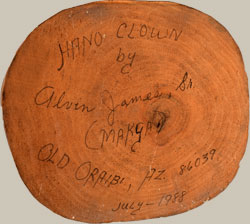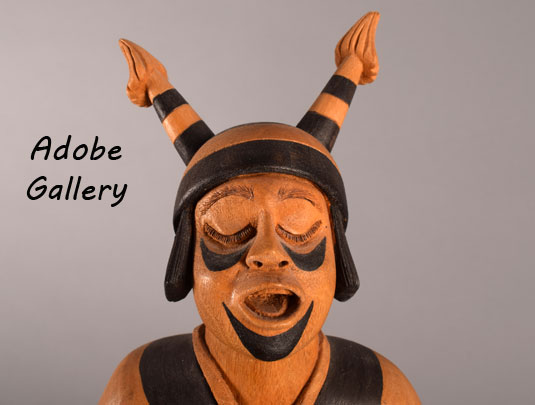Hopi Magnificent Hano Clown by Alvin James Makya [SOLD]
+ Add to my watchlist Forward to Friend
- Category: Traditional
- Origin: Hopi Pueblo, Hopituh Shi-nu-mu
- Medium: wood, paint, stain
- Size:
17-¼” tall, including 3-½” pedestal - Item # C4555D SOLD
 This figure was carved by Hopi artist Alvin James Makya, a resident of Old Oraibi village on the Hopi reservation. He started carving katsina dolls in the 1950s and rapidly mastered the craft. He was known as one of the best carvers in the 1980s. By 1977, his carvings were valued higher than any other carver at the annual Hopi Show. This carving is of the Hopi clown, known by various names—Koshari, Hano Clown, and Koosa.
This figure was carved by Hopi artist Alvin James Makya, a resident of Old Oraibi village on the Hopi reservation. He started carving katsina dolls in the 1950s and rapidly mastered the craft. He was known as one of the best carvers in the 1980s. By 1977, his carvings were valued higher than any other carver at the annual Hopi Show. This carving is of the Hopi clown, known by various names—Koshari, Hano Clown, and Koosa.
This wood carving by Alvin James Makya (1936-ca.2003) appears to be from a single piece of cottonwood root. It was signed and dated July 1988 by the carver. It is one in which the wood was finished with an oil-based stain over which was painted selections with black and green acrylic paint. The stain provides for a more natural skin color than would paint. The musculature of the body is well beyond what other carvers were doing at the time. The wood finish is as fine as any wood sculpture. The pouch around his neck would have been used to hold prayer meal. The watermelon is a sign of gluttony.
“As sacred clowns, the Koosa are the fathers of the kachinas, the purveyors of village mores, and the keepers of tradition. . . Although their avowed purpose is to amuse, the direction their humor takes is, as usual, concerned with that which is beyond the accepted Hopi way of life, be it outsiders, neighboring tribes, individuals, or attitudes that seem aberrant to the group.” [Wright,2004:35]
“Alvin James Makya brought many important contributions to the development of Hopi carving. He made the leap from traditional Katsinas to ‘Action figures’ to fine art wooden sculptures. He also developed new techniques and tried new materials.” [Schaaf, 2008:199]
The artist labeled his carving “Hano Clown”. It is an appropriate name as the clown arrived at Hopi with the New Mexico Tewa immigrants from the northern end of the Rio Grande valley in the early eighteenth century. He has been so thoroughly assimilated that he now appears at all three Hopi mesas.
This carving is extraordinary in its scale, stance, expression, body, and surface finish. There is nothing to fault in any manner.
Condition: excellent condition
Provenance: this Hopi Magnificent Hano Clown by Alvin James Makya is from the estate of a family from New Mexico
References:
-Schaaf, Gregory. Hopi Katsina 1,600 Artist Biographies, 2008.
-Wright, Barton. Clowns of the Hopi: Tradition Keepers and Delight Makers, 2004.
Relative Links: Hopi Pueblo, Katsinas, Alvin James Mayka, Hopi Pueblo Carver

- Category: Traditional
- Origin: Hopi Pueblo, Hopituh Shi-nu-mu
- Medium: wood, paint, stain
- Size:
17-¼” tall, including 3-½” pedestal - Item # C4555D SOLD



